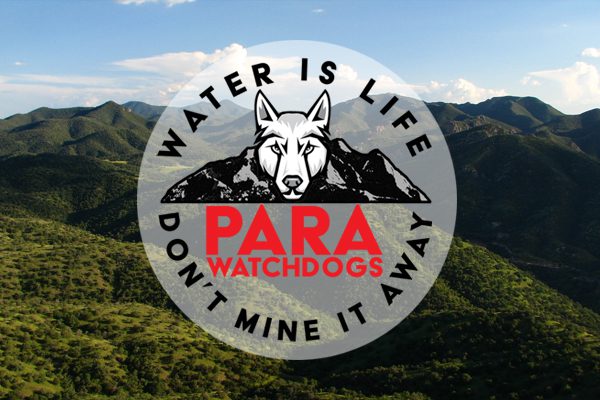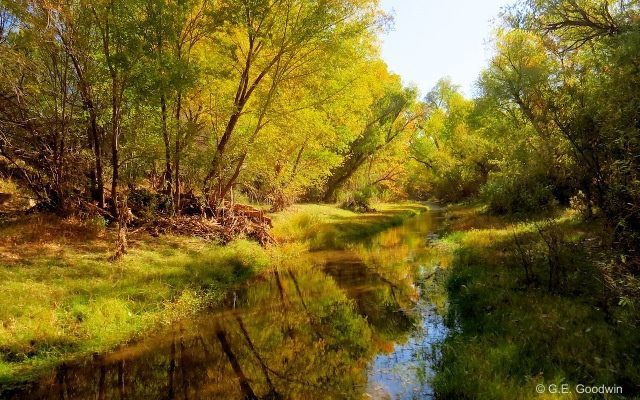Everything you need to know about
Patagonia Area Resource Alliance
—in one place.
Use these resources and frequently-asked questions to get up-to-speed on PARA’s mission, values, and the projects we’re working on. Then, learn how you can get involved to protect the wildlife and water found in the Patagonia Mountains.
Patagonia Area Resource Alliance (PARA) is a grassroots, community-driven nonprofit located in Patagonia, Arizona. Founded in 2011 by six Patagonia locals, we have spent nearly a decade 1) monitoring the wildlife and water found in the Patagonia Mountains and 2) protecting the area’s rich biodiversity from the environmental damage introduced by mining companies.
Mining the Patagonia Mountains:
Modern mining does not meet the standards of responsible mining and cannot sufficiently protect the health and vitality of our ecosystem. The Patagonia Mountains are part of the Madrean Pine Oak Woodlands, a global biodiversity hotspot identified by scientists as one of the top regions in the world most in need of protection for species survival. If the Patagonia region is mined, our water will be polluted, our wildlife will suffer, and our mountains will die.
The Quality of Our Watershed:
Protecting Biodiversity:
Six biological provinces overlap in Arizona’s Sky Island region: the Rocky Mountains, the Sierra Madre, the Sonoran Desert, the Chihuahuan Desert, the Great Plains, and the Neo Tropics. Because of this, the Patagonia Mountains are home to a diverse range of flora and fauna, including over 300 species of birds, 600 species of native bees, 300 types of butterflies and moths, and 100+ Federal/State threatened, endangered, and sensitive species—possibly including jaguars and ocelots that use the mountains to migrate between Mexico and the United States.
Under the threat of large-scale mining and the impacts mining companies have on species’ habitats, water, and breeding grounds, the biodiversity in and around Patagonia suffers. Wildlife should not be a casualty of corporate greed. PARA stands watch for the Patagonia Mountains to ensure mining companies are held accountable for any damage done to the diverse species that live there.
FAQS:
Why are the Patagonia Mountains so important?
Six biological provinces overlap in Arizona’s Sky Island region: the Rocky Mountains, the Sierra Madre, the Sonoran Desert, the Chihuahuan Desert, the Great Plains, and the Neo Tropics. Because of this, the Patagonia Mountains are home to a diverse range of flora and fauna, including over 300 species of birds, 600 species of native bees, 300 types of butterflies and moths, and 100 Federally threatened, endangered, and sensitive species—possibly including jaguars and ocelots.
The Patagonia Mountains have likely been inhabited for about 10,000 years. There is archeological evidence of inhabitants during the Archaic period (7000 – 1 BCE). The Hohokam thrived in this area from about 1050 CE to 1450 CE. The Patagonia Mountains were part of Mexico until annexed to the United States through the 1853 Gadsden Purchase.
The Patagonia Mountains are renowned—locally and internationally—by scientists, hikers, birdwatchers, campers, hunters, mountain bikers, and outdoor enthusiasts. The Town of Patagonia is a gateway community for the 800-mile Arizona National Scenic Trail connecting Mexico to Utah, and the trail itself takes hikers right through the Patagonia Mountains.
But wait! Don’t we need mining for everything we use (goods, services, etc.)?
It’s true that we use mined metals and minerals for everyday goods and services, and rest assured, the team at Patagonia Area Resource Alliance is not asking anyone to give up their iPhones or computers. Modern living does require copper, iron, silver, etc. in some capacity. There will be places on this Earth developed for their minerals and metals.
However, we believe there are certain places in the world where mining should not happen. The Patagonia Mountains—as part of the Madrean Pine Oak Woodlands—are a biodiversity hotspot identified by scientists as one of the top regions in the world most in need of protection for species survival. No kind of mining should occur in this area as a result. The Patagonias are simply too important to be mined, processed, and stripped of wildlife, water, and precious minerals.
If not the Patagonia Mountains, where SHOULD we mine?
It is time to put our heads together and meet our needs for metals and minerals globally. One suggestion we have is to consider the millions of tons of metals that go into landfills every year. For example, the U.S. EPA reports that “landfills received 10.4 million tons of steel” in 2017 (source). Metals, in general, made up 9.9% of the 139.6 million tons of waste landfilled in the U.S that same year (source). Could we not recycle some of this metal to meet our day-to-day demands?
Change will take global conversation, and lots of it. But in order to quickly and efficiently reduce climate pressures, we must re-evaluate our blind acceptance of industries that add to environmental degradation and watershed erosion. This includes 21st century industrialized mining in sensitive areas like the Patagonia Mountains.
What kind of threatened or endangered wildlife can you find in and around Patagonia?
You can view a full list of threatened, endangered, and sensitive species here.
What is the difference between patented and unpatented mining claims?
The legal process of staking claims in the United States goes back to the California/Nevada gold rushes of the 1800s and the 1872 Mining Act. While there have been many adjustments to how companies stake mining claims, the central principle still holds: in the United States, the owner of a mining claim owns whatever minerals rest below the surface.
Patented mining claims are claims for which the U.S. Government has passed its land title to the claimant, giving the claimant (i.e., the mining company) an exclusive title to any locatable minerals, as well as the surface land and all resources (rocks, soil, trees, wildlife), found on that land.
Effective October 1, 1994, the U.S. Congress imposed a moratorium on spending appropriated funds for the acceptance or processing of mineral patent applications that had not yet reached a defined point in the patent review process before a certain cut-off date. Until the moratorium is lifted or expires, the Bureau of Land Management will not accept any new patent applications.
Unpatented mining claims are claims put on parcels of Federal public land by an individual or company. These parcels contain specific and valuable mineral deposits. Unlike a patented claim, unpatented claims restrict the land rights to the development and extraction of the minerals. The land is leased to the company for extraction only. No land ownership is conveyed.
Where does PARA get its funding—and what is it used for?
Patagonia Area Resource Alliance operates almost entirely on the generous donations of people who are concerned about protecting our water and wildlife. We use donations to put on public events, run education programs, fund hard rock mining consultants, staff a full-time communications contractor, and more. Every amount given helps us remain responsive to the needs of the Patagonia Mountains.
Occasionally, PARA will receive grants from places like Patagonia Clothing Company and Fund for Wild Nature. We use these grants to fund any major projects we’re working on (e.g., creating economic reports, printing and distributing educational materials, taking professional videography for PARA-promoted films).
Our Alliances:
Since its founding, PARA has worked with many organizations in Patagonia, Southern Arizona, and the Southwestern U.S. These alliances—see below—help ensure the successful protection, conservation, and restoration of the Patagonia Mountains.
Local Orgs (Patagonia/Sonoita/Elgin):
- Arizona Trail Association
- Borderlands Restoration
- Circle Z
- Deep Dirt Farm Institute
- Friends of Santa Cruz River
- Friends of Sonoita Creek
- Hummingbird Monitoring Network
- National Audubon Society – Appleton-Whittell Research Ranch
- Ravens Way Wild Journeys
- The Nature Conservancy – Patagonia-Sonoita Creek Preserve
Tucson-Based Orgs:
- Save the Scenic Santa Ritas
- Sky Island Alliance
- The Tucson Audubon Paton Center
National Orgs:
- Defenders of Wildlife
- Earthworks
- Center for Biological Diversity
Plus, as a reminder: You can write donations off on your taxes!
We’re always looking for volunteers who can give time or expertise toward our current projects. If you’re skilled or knowledgeable in one of these areas, let us know! We’d love to connect with you.
- Field research
- Grant writing
- Data analysis
- Social media outreach
- Graphic design
- Video editing
Never underestimate the power of your voice. As a citizen of our planet, with a stake in the health of our water and wildlife, you have every right to make your concerns known.
One way to speak up is by writing to your local newspaper editor or local elected officials—read our Communicating with Legislators (PDF). When drafting a letter, consider mentioning: 1) the very outdated 1872 Mining Act, 2) the unsustainability of 21st century industrialized mining, 3) the need to respond immediately and seriously to climate change, and 4) our moral imperative to protect the Earth and its habitats for species survival.
You can also speak by exercising your right to vote. Arizona laws and regulations around mining are incredibly lax—for example, Santa Cruz County is not allowed to regulate mining activity that exists on more than five acres of land (ARS 11-812). By casting your vote, you can help ensure our elected officials listen to the people—and biodiversity—they represent.
Everything you need to know about Patagonia Area Resource Alliance
—in one place.
Mining the Patagonia Mountains:
The Quality of Our Watershed:
Protecting Biodiversity:
Six biological provinces overlap in Arizona’s Sky Island region: the Rocky Mountains, the Sierra Madre, the Sonoran Desert, the Chihuahuan Desert, the Great Plains, and the Neo Tropics. Because of this, the Patagonia Mountains are home to a diverse range of flora and fauna, including over 300 species of birds, 600 species of native bees, 300 types of butterflies and moths, and 100 Federally threatened, endangered, and sensitive species—possibly including jaguars and ocelots that use the mountains to migrate between Mexico and the United States.
Under the threat of large-scale mining and the impacts mining companies have on species’ habitats, water, and breeding grounds, the biodiversity in and around Patagonia suffers. Wildlife should not be a casualty of corporate greed. PARA stands watch for the Patagonia Mountains to ensure mining companies are held accountable for any damage done to the diverse species that live there.
Our Alliances:
Since its founding, PARA has worked with many organizations in Patagonia, Southern Arizona, and the Southwestern U.S. These alliances—see below—help ensure the successful protection, conservation, and restoration of the Patagonia Mountains.
Local Orgs (Patagonia/Sonoita/Elgin):
- Arizona Trail Association
- Borderlands Restoration
- Circle Z
- Deep Dirt Farm Institute
- Friends of Santa Cruz River
- Friends of Sonoita Creek
- Hummingbird Monitoring Network
- National Audubon Society – Appleton-Whittell Research Ranch
- Ravens Way Wild Journeys
- The Nature Conservancy – Patagonia-Sonoita Creek Preserve
Tucson-Based Orgs:
- Save the Scenic Santa Ritas
- Sky Island Alliance
- The Tucson Audubon Paton Center
National Orgs:
- Defenders of Wildlife
- Earthworks
- Center for Biological Diversity
FAQS:
Why are the Patagonia Mountains so important?
Six biological provinces overlap in Arizona’s Sky Island region: the Rocky Mountains, the Sierra Madre, the Sonoran Desert, the Chihuahuan Desert, the Great Plains, and the Neo Tropics. Because of this, the Patagonia Mountains are home to a diverse range of flora and fauna, including over 300 species of birds, 600 species of native bees, 300 types of butterflies and moths, and 100 Federally threatened, endangered, and sensitive species—possibly including jaguars and ocelots.
The Patagonia Mountains have likely been inhabited for about 10,000 years. There is archeological evidence of inhabitants during the Archaic period (7000 – 1 BCE). The Hohokam thrived in this area from about 1050 CE to 1450 CE. The Patagonia Mountains were part of Mexico until annexed to the United States through the 1853 Gadsden Purchase.
The Patagonia Mountains are renowned—locally and internationally—by scientists, hikers, birdwatchers, campers, hunters, mountain bikers, and outdoor enthusiasts. The Town of Patagonia is a gateway community for the 800-mile Arizona National Scenic Trail connecting Mexico to Utah, and the trail itself takes hikers right through the Patagonia Mountains.
But wait! Don’t we need mining for everything we use (goods, services, etc.)?
It’s true that we use mined metals and minerals for everyday goods and services, and rest assured, the team at Patagonia Area Resource Alliance is not asking anyone to give up their iPhones or computers. Modern living does require copper, iron, silver, etc. in some capacity. There will be places on this Earth developed for their minerals and metals.
However, we believe there are certain places in the world where mining should not happen. The Patagonia Mountains—as part of the Madrean Pine Oak Woodlands—are a biodiversity hotspot identified by scientists as one of the top regions in the world most in need of protection for species survival. No kind of mining should occur in this area as a result. The Patagonias are simply too important to be mined, processed, and stripped of wildlife, water, and precious minerals.
If not the Patagonia Mountains, where SHOULD we mine?
It is time to put our heads together and meet our needs for metals and minerals globally. One suggestion we have is to consider the millions of tons of metals that go into landfills every year. For example, the U.S. EPA reports that “landfills received 10.4 million tons of steel” in 2017 (source). Metals, in general, made up 9.9% of the 139.6 million tons of waste landfilled in the U.S that same year (source). Could we not recycle some of this metal to meet our day-to-day demands?
Change will take global conversation, and lots of it. But in order to quickly and efficiently reduce climate pressures, we must re-evaluate our blind acceptance of industries that add to environmental degradation and watershed erosion. This includes 21st century industrialized mining in sensitive areas like the Patagonia Mountains.
What kind of threatened or endangered wildlife can you find in and around Patagonia?
You can view a full list of threatened, endangered, and sensitive species here.
What is the difference between patented and unpatented mining claims?
The legal process of staking claims in the United States goes back to the California/Nevada gold rushes of the 1800s and the 1872 Mining Act. While there have been many adjustments to how companies stake mining claims, the central principle still holds: in the United States, the owner of a mining claim owns whatever minerals rest below the surface.
Patented mining claims are claims for which the U.S. Government has passed its land title to the claimant, giving the claimant (i.e., the mining company) an exclusive title to any locatable minerals, as well as the surface land and all resources (rocks, soil, trees, wildlife), found on that land.
Effective October 1, 1994, the U.S. Congress imposed a moratorium on spending appropriated funds for the acceptance or processing of mineral patent applications that had not yet reached a defined point in the patent review process before a certain cut-off date. Until the moratorium is lifted or expires, the Bureau of Land Management will not accept any new patent applications.
Unpatented mining claims are claims put on parcels of Federal public land by an individual or company. These parcels contain specific and valuable mineral deposits. Unlike a patented claim, unpatented claims restrict the land rights to the development and extraction of the minerals. The land is leased to the company for extraction only. No land ownership is conveyed.
Where does PARA get its funding—and what is it used for?
Patagonia Area Resource Alliance operates almost entirely on the generous donations of people who are concerned about protecting our water and wildlife. We use donations to put on public events, run education programs, fund hard rock mining consultants, staff a full-time communications contractor, and more. Every amount given helps us remain responsive to the needs of the Patagonia Mountains.
Occasionally, PARA will receive grants from places like Patagonia Clothing Company and Fund for Wild Nature. We use these grants to fund any major projects we’re working on (e.g., creating economic reports, printing and distributing educational materials, taking professional videography for PARA-promoted films).
Plus, as a reminder: You can write donations off on your taxes!
We’re always looking for volunteers who can give time or expertise toward our current projects. If you’re skilled or knowledgeable in one of these areas, let us know! We’d love to connect with you.
- Grant writing
- Data analysis
- Social media outreach
- Graphic design
- Video editing
- Field research
Never underestimate the power of your voice. As a citizen of our planet, with a stake in the health of our water and wildlife, you have every right to make your concerns known.
One way to speak up is by writing to your local newspaper editor or local elected officials—read our Communicating with Legislators (PDF). When drafting a letter, consider mentioning: 1) the very outdated 1872 Mining Act, 2) the unsustainability of 21st century industrialized mining, 3) the need to respond immediately and seriously to climate change, and 4) our moral imperative to protect the Earth and its habitats for species survival.
You can also speak by exercising your right to vote. Arizona laws and regulations around mining are incredibly lax—for example, Santa Cruz County is not allowed to regulate mining activity that exists on more than five acres of land (ARS 11-812). By casting your vote, you can help ensure our elected officials listen to the people—and biodiversity—they represent.


